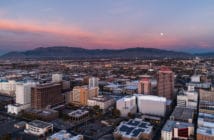 Clean and Sober Streets Review
Clean and Sober Streets Review
Clean and Sober Streets is a Washington DC based non-profit that provides free rehabilitation services for substance abuse, and caters mostly to the homeless and financially distressed. Located downtown near Judiciary Square and Union Station, C&SS was founded in 1987 by Julia Lightfoot, a recovering addict from Minnesota, and Marsh Ward, a psychotherapist. Lightfoot came to DC to tackle the city’s overwhelming problems of substance abuse and homelessness, decided to open a treatment and recruited Ward to help. Due to their politically charged location, C&SS has drawn attention from politicians, including DC mayor Vincent Gray, ex-drug czar R. Gil Kerlikowske and the late Mike Deaver of the Reagan administration, over the years . Since its inception, C&SS has helped over 4,800 people.
Accommodations and Food
C&SS is a 100-bed facility, though it’s usually not at full capacity. Their facilities aren’t fancy, and have a somewhat medical feel to them with some homey touches. Each resident has a roommate, and live in dorm style housing with two twin beds. Every dorm has an in-room locker, though the staff maintain that it’s merely a pre-cautionary measure for residents’ peace of mind. Overall, C&SS tries to maintain a safe, community vibe at their facility.
Food service at C&SS includes three meals a day along with a snack time, all cafeteria-style. Meals vary, but may include entrees of spaghetti, burgers and fries, fish and mashed potatoes or green salads. Accommodations can be made for allergies if necessary, but some of the trendier diets will probably be difficult to work around here. Residents are also allowed to buy and keep some food in their rooms as well if desired.
Treatment and Staff
Their program emphasizes community immersion, and welcomes those with dual diagnosis issues as well as cases of straight addiction. Staff is limited due to financial constraints, though it includes Lightfoot herself, three counselors, a clinical director (also a certified counselor) and an on-site nurse. The staff-to-client ratio varies, but typically falls between six or eight clients per staff member. Though the numbers seem low, C&SS generally has only between 35-45 residents at a time to keep things manageable; specialized programs get help from affiliated outsiders.
C&SS embraces 12-step philosophy throughout treatment and even hosts meetings for non-residents on site, making it easy for clients to attend and find extra support if necessary. C&SS also does CBT and DBT on top of a four-phase treatment program.
Phase one is detox and intensive treatment, which includes educational classes and art therapy as well as nutritional and physical rejuvenation on top of standard therapy sessions and AA or NA meetings. Phase two builds residents’ self-confidence and life skills with offerings like the Back on My Feet running program where they run three days a week and even participate in races, computer classes, job training, exercise classes and GED training.
Generally, residents rise at about 6 or 7 am and start the day with a morning walk and breakfast. After that, individual and group therapy sessions take place for several hours. Staff provides at least four hours of individual treatment counseling per week, though residents often get more than that. Attendance and participation in AA is mandatory throughout each phase of treatment, and during off time residents can socialize, watch television or head to the gym. On weekdays, lights out is at 10pm, but residents are allowed to watch TV in the entertainment room until midnight. On weekends, they may stay up until 2 am with the same privileges.
During the first 30 days of treatment, residents are completely isolated from the outside world: no visitors, no phones, no laptops and no leaving the facility. After 60 days, phones or laptops are allowed on a case-by-case basis, depending on progress. Visitors are not allowed at all, but once a resident has graduated from Phase One, they can leave the facility for a few hours on weekends to see family depending on the destination. Again, these privileges are on a case-by case basis with staff oversight.
Phase three is a transitional phase where residents seek employment or vocational training outside of the facility. Their destinations must be cleared with staff and they also must have proof of their whereabouts, though they also continue to stay at C&SS and engage in meetings and activities whenever possible; decisions on this are made on a case-by-case basis.
Finally, phase four begins when clients are employed and in the process of finding outside housing with assistance and further counseling from C&SS. Clients continue to follow a structured schedule (including AA and NA meetings), but will be given more freedom to allow proper re-entry to the real world; again, staff will need to be informed of where and when clients come and go.
Extras
Bonus activities vary by the day. On Tuesdays, residents play basketball (on outdoor or indoor courts, depending on weather) and work with an on-site personal trainer. Thursdays are for yoga and meditation, Fridays include Qi Gong and acupuncture and on Saturdays residents can take a few hours off to watch sports or a movie. C&SS does a “Coffee House” on the first Monday of every month, where residents can read poetry, sing and discuss art. The facility also has an exercise room and an entertainment room with a television, which residents can use whenever they have free time.
There’s also C&SS’s enormously successful CASSA Arts Workshop, where art teacher Ruth Stenstrom teaches residents basic drawing, photography, painting, computer graphics and silkscreen skills. Residents’ work from this program has been displayed in the Martin Luther King Memorial Library, among other prestigious venues.
C&SS offers two extra phases for unemployed and homeless residents who need help finding jobs, gaining work experience or renting a place to live without relapsing.
In Summary
Overall, C&SS can help a resident get clean, make friends and grow without the accommodations and treatments of expensive facilities. This program is great considering that it’s free, but clients should expect a little rough around the edges due to the inner city location and acceptance of applicants with violent pasts. Though they’re strict on discipline, this isn’t a Malibu rehab—and it shouldn’t be.
Clean and Sober St Location
452 2nd Street NW
Washington, DC 20001
Clean and Sober St Cost
Clean and Sober Streets Cost: Free. Clean and Sober Streets can be reached at (202) 783-7343. Find Clean and Sober Streets on Facebook
Do you have a complaint or review of Clean and Sober Streets to add? Use the comments area below to add your Clean and Sober Streets review.
Photo courtesy of GoogleEarth
Sponsored DISCLAIMER: This is a paid advertisement for California Behavioral Health, LLC, a CA licensed substance abuse treatment provider and not a service provided by The Fix. Calls to this number are answered by CBH, free and without obligation to the consumer. No one who answers the call receives a fee based upon the consumer’s choice to enter treatment. For additional info on other treatment providers and options visit www.samhsa.gov.



